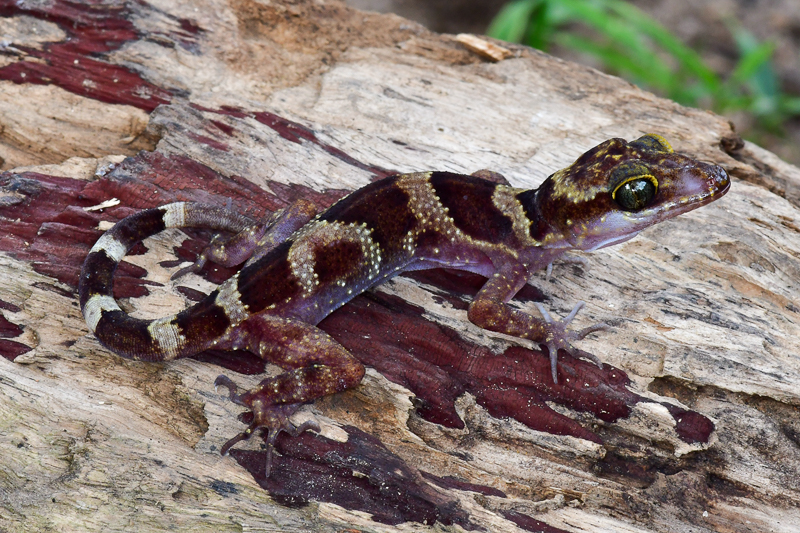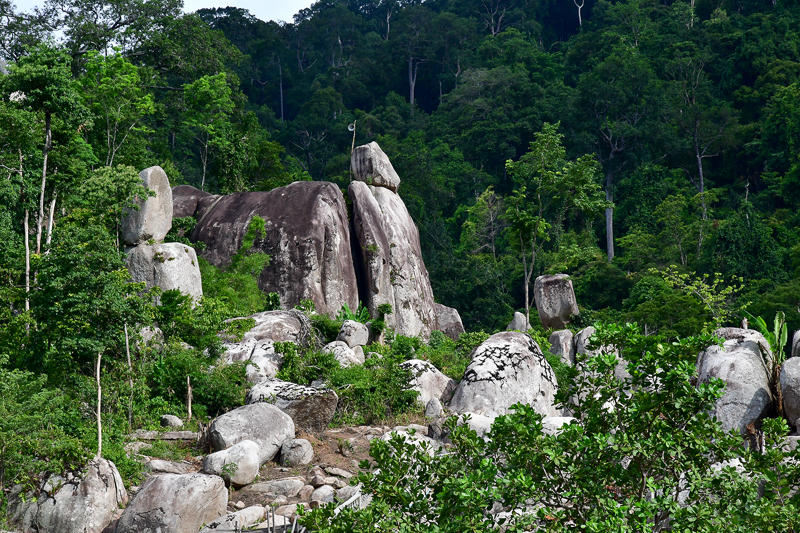Scientists discover bent-toed gecko species in Cambodia
For immediate release ‐ April 13, 2020
Contact: Chris Berry, Wild Earth Allies, 330.603.7945 and Bryan Stuart, NC Museum of Natural Sciences, 919.600.2422. Images available upon request
 A new species of bent-toed gecko (Cyrtodactylus phnomchiensis) has been described from Cambodia’s Prey Lang Wildlife Sanctuary by Wild Earth Allies Biologist Thy Neang in collaboration with North Carolina Museum of Natural Sciences’ Herpetologist Bryan Stuart. Photo: Thy Neang. Click photo to enlarge.
A new species of bent-toed gecko (Cyrtodactylus phnomchiensis) has been described from Cambodia’s Prey Lang Wildlife Sanctuary by Wild Earth Allies Biologist Thy Neang in collaboration with North Carolina Museum of Natural Sciences’ Herpetologist Bryan Stuart. Photo: Thy Neang. Click photo to enlarge.
A new species of bent-toed gecko (Cyrtodactylus phnomchiensis) has been described from Cambodia’s Prey Lang Wildlife Sanctuary by Wild Earth Allies Biologist Thy Neang in collaboration with North Carolina Museum of Natural Sciences’ Herpetologist Bryan Stuart. This new species is described in ZooKeys.
The species was discovered by Thy Neang during Wild Earth Allies field surveys in June-July 2019 on an isolated mountain named Phnom Chi in the Prey Lang Wildlife Sanctuary when he encountered an unusual species of bent-toed gecko. “It was an extremely unexpected discovery. No one thought there were undescribed species in Prey Lang,” said Neang.
The geckos were found to belong to the C. irregularis species complex that includes at least 19 species distributed in southern and central Vietnam, eastern Cambodia, and southern Laos. This is the first member of the complex to be found west of the Mekong River, demonstrating how biogeographic barriers can lead to speciation. Additionally, the geckos were unique in morphological characters and mitochondrial DNA, and distinct from C. ziegleri, to which they are most closely related. Researchers have named the species Cyrtodactylus phnomchiensis after Phnom Chi mountain where it was found.
Bent-toed geckos of the genus Cyrtodactylus are one of the most species-diverse genera of gekkonid lizards, with 292 recognized species. Much of the diversity within Cyrtodactylus has been described only during the past decade and from mainland Southeast Asia, and many of these newly recognized species are thought to have extremely narrow geographic ranges. As such, Cyrtodactylus phnomchiensis is likely endemic to Phnom Chi, which consists of an isolated small mountain of rocky outcrops (peak of 652 m elevation) and a few associated smaller hills, altogether encompassing an area of approximately 4,464 hectares in Kampong Thom and Kratie Provinces within the Prey Lang Wildlife Sanctuary, Cambodia.
 Habitat at Phnom Chi, the type locality of Cyrtodactylus phnomchiensis. Photo: Thy Neang. Click photo to enlarge.
Habitat at Phnom Chi, the type locality of Cyrtodactylus phnomchiensis. Photo: Thy Neang. Click photo to enlarge.
The forest habitat in Phnom Chi remains in relatively good condition, but small-scale illegal gold extraction around its base threatens the newly discovered species. A second species of lizard, the scincid Sphenomorphus preylangensis, was also recently described from Phnom Chi by a team of researchers including Neang. These new discoveries underscore the importance of Prey Lang Wildlife Sanctuary for biodiversity conservation and the critical need to strengthen its management.
Further, an assessment of C. phnomchiensis is urgently warranted by the IUCN Red List of Threatened Species (IUCN 2020) because of its small area of occupancy, status as relatively uncommon, and ongoing threats to its habitat.
“This exciting discovery adds another reptile species to science for Cambodia and the world. It also highlights the global importance of Cambodia’s biodiversity and illustrates the need for future exploration and biological research in Prey Lang,” said Neang.
“When [Neang] first returned from fieldwork and told me that he had found a species in the C. irregularis group so far west of the Mekong River in Cambodia, I did not believe it. His discovery underscores how much unknown biodiversity remains out there in unexpected places. Clearly, Prey Lang Wildlife Sanctuary is important for biodiversity and deserves attention,” said Neang’s co-author Stuart of the North Carolina Museum of Natural Sciences.
For more information on Wild Earth Allies, please visit www.wildearthallies.org. For more information on the North Carolina Museum of Natural Sciences, please visit www.naturalsciences.org.
Note to Editors: The study abstract follows.
“A new species of Cyrtodactylus (Squamata, Gekkonidae) from Cambodia’s Prey Lang Wildlife Sanctuary”
Published:April 13, 2020, ZooKeys
DOI:https://doi.org/10.3897/zookeys.926.48671 [doi.org]
Abstract: Cyrtodactylus phnomchiensis sp. nov. is described from Phnom Chi, an isolated mountain in Kampong Thom Provincewithin the Prey Lang Wildlife Sanctuary, Cambodia. The new species is recognized by having a unique combination of morphological characters, including snout-vent length 76.1–80.7 mm; paravertebral tubercles 31–36; ventral scales 45–54; enlarged femoral scales 0–8, without pores; enlarged precloacal scales 7–10, bearing pores 4–5 in males, pits 1–7 in females; the posterior border of nuchal loop unbroken and pointed, bordered anteriorly and posteriorly by a broad yellow or yellowish white band; and yellow spots on top of head. The new species also represents a divergent mitochondrial DNA lineage within the C. irregularis complex that is closely related to C. ziegleri, but the phylogenetic relationships among the new species and two divergent mitochondrial subclades within C. ziegleri are not resolved based on available sequence data. Cyrtodactylus phnomchiensis sp. nov. is the only member of the C. irregularis complex known to occur west of the Mekong River. The new species may be endemic to Phnom Chi, and likely faces imminent conservation threats.
Authors/Affiliations:
Thy Neang1, Adam Henson2, Bryan L. Stuart3
1 Wild Earth Allies, 77a Street Beton, Bayap Village, Sangkat Phnom Penh Thmei, Khan Sen Sok, Phnom Penh, Cambodia; 2 Wild Earth Allies, 2 Wisconsin Circle, Suite 900, Chevy Chase, Maryland 20815, USA; 3 North Carolina Museum of Natural Sciences, 11 West Jones Street, Raleigh, North Carolina 27601, USA.
Funding/Acknowledgements:
Wild Earth Allies is grateful to the General Department of Administration for Nature Conservation and Protection, Ministry of Environment of Cambodia, for providing permission to conduct research in Prey Lang Wildlife Sanctuary. Rangers of the Environmental Department of Kampong Thom Province, En E (Field Assistant, Wild Earth Allies), and community members living at the foot of Phnom Chi assisted with field work. Field work was implemented with funding support from Wild Earth Allies. Sereivathana Tuy (Cambodia Director, Wild Earth Allies) provided technical support to the project. Hannah E. Som assisted with sequencing DNA and preparing figures. Thomas Ziegler and two anonymous reviewers improved the manuscript.

